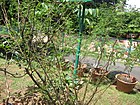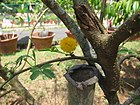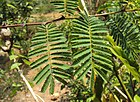Note: This is a project under development. The articles on this wiki are just being initiated and broadly incomplete. You can Help creating new pages.
Difference between revisions of "Senegalia catechu - Khadira"
Chaithrika (talk | contribs) (+Common names) |
(→References) |
||
| (13 intermediate revisions by 2 users not shown) | |||
| Line 1: | Line 1: | ||
[[File:Khair (Acacia catechu) leaves & fruits at Hyderabad, AP W IMG 7263.jpg|thumb|right|''Senegalia catechu'', ''Khadira'']] | [[File:Khair (Acacia catechu) leaves & fruits at Hyderabad, AP W IMG 7263.jpg|thumb|right|''Senegalia catechu'', ''Khadira'']] | ||
| + | '''Senegalia catechu''' is a deciduous thorny tree which grows up to 15 m in height. | ||
| − | + | ==Uses== | |
| + | {{Uses|Chronic catarrh}}, {{Uses|Chronic diarrhoea}}, {{Uses|Dysentery}}, {{Uses|Foliage}}, {{Uses|Skin eruptions}}. | ||
| − | + | ==Parts Used== | |
| + | {{Parts Used|Flowers}}, {{Parts Used|Leaves}}. | ||
| − | == | + | ==Chemical Composition== |
| + | Catechin, catechu-tannic acid and tannin, Hydroxy benzoic acid, kaempferol, quercetin, 3,4',7-trihydroxyl-3', 5-dimethoxyflavone, catechin, epicatechin, afzelechin, epiafzelechin, mesquitol, ophioglonin, aromadendrin, and phenol<ref name="chemical composition"/> | ||
| − | + | ==Common names== | |
| − | + | {{Common names|sa=Gaayatri|en=Black catechu, Cutch tree.|gu=Khair, Kathe, Kher|hi=Khair|kn=Kaggali, Kaggalinara, Kachinamara, Koggigida |ks=Kath|ml=Karingali|mr=Khaira, Khair|pa=Khair|ta=Karungali, Karungkali|te=Chandra, Kaviri}} | |
| − | |||
| − | |||
| − | |||
| − | |||
| − | == | + | ==Properties== |
| + | Reference: Dravya - Substance, Rasa - Taste, Guna - Qualities, Veerya - Potency, Vipaka - Post-digesion effect, Karma - Pharmacological activity, Prabhava - Therepeutics. | ||
| + | ===Dravya=== | ||
| − | * | + | ===Rasa=== |
| − | + | Tikta (Bitter), Kashaya (Astringent) | |
| − | + | ===Guna=== | |
| + | Laghu (Light), Ruksha (Dry) | ||
| + | ===Veerya=== | ||
| + | Sheeta (cold) | ||
| + | ===Vipaka=== | ||
| + | Katu (Pungent) | ||
| + | ===Karma=== | ||
| + | Kapha, Pitta | ||
| + | ===Prabhava=== | ||
| + | |||
| + | ==Habit== | ||
| + | {{Habit|Deciduous tree}} | ||
| + | |||
| + | ==Identification== | ||
| + | ===Leaf=== | ||
| + | {{Leaf|Bipinnate|Alternate|Leaves 2-pinnate, pinnae 40-80, leaflets 60-100, small ligulate}}<ref name="Leaf"/> | ||
| + | |||
| + | ===Flower=== | ||
| + | {{Flower|Bisexual|2-4cm long|Yellow|5-20|Flowers small, pale yellow or white in cylindrical axillary spikes}} | ||
| + | |||
| + | ===Fruit=== | ||
| + | {{Fruit|Flat pod|5-10 x 1-1.6 cm||flat, straight, unlobed or sinuate along margins, thin walled, beaked at apex, brown, narrowed at base into a stipe, dehiscent; seeds 3-10, orbicular or ovate, flattened.|}} | ||
| + | |||
| + | ===Other features=== | ||
| + | |||
| + | ==List of Ayurvedic medicine in which the herb is used== | ||
| + | * [[Khadiradi gutika]] | ||
| + | * [[Khadirarishtam]] | ||
| + | * [[Khadiradi vati]] | ||
| + | * [[Dashamoolarishtam]] | ||
| + | * [[Khadiradi kashaya]] | ||
| + | <ref name="Ayurvedic preparations"/> | ||
| + | |||
| + | ==Where to get the saplings== | ||
| + | ==Mode of Propagation== | ||
| + | {{Propagation|Seeds}}, {{Propagation|Cuttings}}. | ||
| + | |||
| + | ==How to plant/cultivate== | ||
| + | A plant for sub-tropical to tropical areas, tolerating a minimum temperature of about 7c. It is especially common in the drier regions, but can also be grown in the more humid climates of South-East Asia at elevations from sea-level to about 1,500 metres<ref name="How to plant/cultivate"/> | ||
| + | |||
| + | ==Commonly seen growing in areas== | ||
| + | {{Commonly seen|On well drained soil areas}}, {{Commonly seen|Open areas}}, {{Commonly seen|Drier areas}}, {{Commonly seen|Sandy soil areas}}. | ||
| + | |||
| + | ==Photo Gallery== | ||
| + | <gallery class="left" caption="" widths="140px" heights="140px"> | ||
| + | |||
| + | Acacia cartechu TSV 1246.JPG | ||
| + | |||
| + | Acacia catechu - കരിങ്ങാലി 01.JPG | ||
| + | |||
| + | |||
| + | Acacia catechu - കരിങ്ങാലി 02.JPG | ||
| + | |||
| + | |||
| + | Acacia catechu - കരിങ്ങാലി 03.JPG | ||
| + | |||
| + | |||
| + | Acacia catechu 01.JPG | ||
| − | |||
| − | <references> | + | Acacia catechu 02.JPG |
| − | <ref name=" | + | |
| + | </gallery> | ||
| + | |||
| + | ==References== | ||
| + | |||
| + | <references> | ||
| + | <ref name="chemical composition">[https://www.ncbi.nlm.nih.gov/pubmed/20822013 "Chemical constituents"]</ref> | ||
| + | |||
| + | <ref name="Leaf">[http://www.mpbd.info/plants/acacia-catechu.php "plant decsription"]</ref> | ||
| + | |||
| + | <ref name="How to plant/cultivate">[https://pfaf.org/user/Plant.aspx?LatinName=Senegalia+catechu "Cultivation details"]</ref> | ||
| + | <ref name="Ayurvedic preparations">[https://easyayurveda.com/2012/12/27/khadira-acacia-catechu-uses-qualities-ayurveda-details/ "Ayurvedic preparations"]</ref> | ||
| + | |||
</references> | </references> | ||
| − | == External Links == | + | ==External Links== |
| + | * [http://www.planetayurveda.com/library/black-catechu Senegalia catechu on planet ayurveda] | ||
| + | * [http://www.alwaysayurveda.com/acacia-catechu/ Senegalia catechu on always ayurveda] | ||
| + | * [http://www.frienvis.nic.in/WriteReadData/UserFiles/file/pdfs/Khair.pdf Senegalia catechu on frienvis.nic.in] | ||
| − | |||
[[Category:Herbs]] | [[Category:Herbs]] | ||
| + | [[Category:Fabaceae]] | ||
Latest revision as of 10:35, 13 June 2019
Senegalia catechu is a deciduous thorny tree which grows up to 15 m in height.
Contents
- 1 Uses
- 2 Parts Used
- 3 Chemical Composition
- 4 Common names
- 5 Properties
- 6 Habit
- 7 Identification
- 8 List of Ayurvedic medicine in which the herb is used
- 9 Where to get the saplings
- 10 Mode of Propagation
- 11 How to plant/cultivate
- 12 Commonly seen growing in areas
- 13 Photo Gallery
- 14 References
- 15 External Links
Uses
Chronic catarrh, Chronic diarrhoea, Dysentery, Foliage, Skin eruptions.
Parts Used
Chemical Composition
Catechin, catechu-tannic acid and tannin, Hydroxy benzoic acid, kaempferol, quercetin, 3,4',7-trihydroxyl-3', 5-dimethoxyflavone, catechin, epicatechin, afzelechin, epiafzelechin, mesquitol, ophioglonin, aromadendrin, and phenol[1]
Common names
| Language | Common name |
|---|---|
| Kannada | Kaggali, Kaggalinara, Kachinamara, Koggigida |
| Hindi | Khair |
| Malayalam | Karingali |
| Tamil | Karungali, Karungkali |
| Telugu | Chandra, Kaviri |
| Marathi | Khaira, Khair |
| Gujarathi | Khair, Kathe, Kher |
| Punjabi | Khair |
| Kashmiri | Kath |
| Sanskrit | Gaayatri |
| English | Black catechu, Cutch tree. |
Properties
Reference: Dravya - Substance, Rasa - Taste, Guna - Qualities, Veerya - Potency, Vipaka - Post-digesion effect, Karma - Pharmacological activity, Prabhava - Therepeutics.
Dravya
Rasa
Tikta (Bitter), Kashaya (Astringent)
Guna
Laghu (Light), Ruksha (Dry)
Veerya
Sheeta (cold)
Vipaka
Katu (Pungent)
Karma
Kapha, Pitta
Prabhava
Habit
Identification
Leaf
| Kind | Shape | Feature |
|---|---|---|
| Bipinnate | Alternate | Leaves 2-pinnate, pinnae 40-80, leaflets 60-100, small ligulate |
Flower
| Type | Size | Color and composition | Stamen | More information |
|---|---|---|---|---|
| Bisexual | 2-4cm long | Yellow | 5-20 | Flowers small, pale yellow or white in cylindrical axillary spikes |
Fruit
| Type | Size | Mass | Appearance | Seeds | More information |
|---|---|---|---|---|---|
| Flat pod | 5-10 x 1-1.6 cm | flat, straight, unlobed or sinuate along margins, thin walled, beaked at apex, brown, narrowed at base into a stipe, dehiscent; seeds 3-10, orbicular or ovate, flattened. | {{{6}}} |
Other features
List of Ayurvedic medicine in which the herb is used
Where to get the saplings
Mode of Propagation
How to plant/cultivate
A plant for sub-tropical to tropical areas, tolerating a minimum temperature of about 7c. It is especially common in the drier regions, but can also be grown in the more humid climates of South-East Asia at elevations from sea-level to about 1,500 metres[4]
Commonly seen growing in areas
On well drained soil areas, Open areas, Drier areas, Sandy soil areas.
Photo Gallery
References
External Links
- Ayurvedic Herbs known to be helpful to treat Chronic catarrh
- Ayurvedic Herbs known to be helpful to treat Chronic diarrhoea
- Ayurvedic Herbs known to be helpful to treat Dysentery
- Ayurvedic Herbs known to be helpful to treat Foliage
- Ayurvedic Herbs known to be helpful to treat Skin eruptions
- Herbs with Flowers used in medicine
- Herbs with Leaves used in medicine
- Herbs with common name in Kannada
- Herbs with common name in Hindi
- Herbs with common name in Malayalam
- Herbs with common name in Tamil
- Herbs with common name in Telugu
- Herbs with common name in Marathi
- Herbs with common name in Gujarathi
- Herbs with common name in Punjabi
- Herbs with common name in Kashmiri
- Herbs with common name in Sanskrit
- Herbs with common name in English
- Habit - Deciduous tree
- Index of Plants which can be propagated by Seeds
- Index of Plants which can be propagated by Cuttings
- Herbs that are commonly seen in the region of On well drained soil areas
- Herbs that are commonly seen in the region of Open areas
- Herbs that are commonly seen in the region of Drier areas
- Herbs that are commonly seen in the region of Sandy soil areas
- Herbs
- Fabaceae






